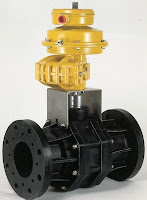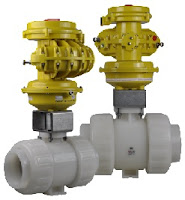 |
| Kinetrol Actuator on Thermoplastic Valves |
For example, many chemicals used to treat drinking water and wastewater use plastic valves because they stand up to the caustic and aggressive chemicals such as sodium hypochlorite, sodium hydroxide, sodium bisulfite, hydrofluosilisic acid and potassium permanganate.
 |
| Kinetrol Actuator on Thermoplastic Valves |
In the high purity industries such as the semiconductor industry, fluoropolymer valves are required for aqueous chemicals, solvents and slurries. In these applications chemical contamination must be less than 100 parts per trillion (ppt) total contamination from the entire piping system (including valves, fittings, tubing, filters and instrumentation). Other ultra-pure application examples are microelectronics, medical devices and pharmaceutical production.
Thermoplastic valves are sensitive to temperature changes and experience a higher degree of thermal expansion and contraction than their metal counterparts, but most agree the advantages far outweigh these concerns.
The key to actuating plastic valves is like any other valve system - understanding the operating requirements of system. It's important to remember that since most plastic valves are used on corrosive media, there's a fair chance the actuator may be exposed to corrosives as well. Effects on the actuator housing, internal parts, and any springs have to be considered. In most cases the actuator will have to be specially coated or come with a corrosion-resistant epoxy finish. Kinetrol actuators fit the bill as they come standardly with an epoxy stove enamel finish and stainless steel internal and external hardware, and Kinetrol spring units are totally sealed from the atmosphere, protecting the spring element and assuring long life.